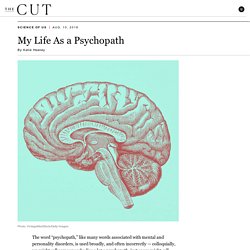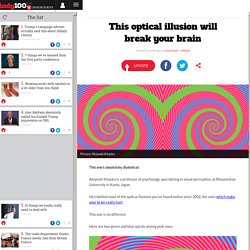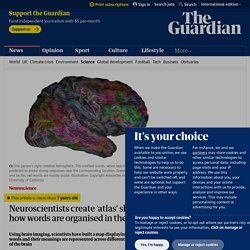

History vs. Sigmund Freud - Todd Dufresne. What is schizophrenia? - Anees Bahji. What is consciousness? - Michael S. A. Graziano. How does the Rorschach inkblot test work? - Damion Searls. Synaesthesia: The condition which means you can 'taste' sounds and 'hear' colours. Ever wondered what Wednesday looks like?

How it tastes? Which colour it is? If the answer to any of these questions is yes, you might be one of the few people with synaesthesia: a neurological condition that causes the brain to combine senses that wouldn’t otherwise be linked. While a regular person listens to music and hears a song, a synaesthete may listen to music and see a colour, or eat a steak and hear a sound.
One per cent of people have synaesthesia, according to Harvard Medical School, with notable synaesthetes including Vladimir Nabokov, Pharrell Williams and Marilyn Monroe. What It’s Like Living As a Diagnosed Psychopath. Photo: VintageMedStock/Getty Images The word “psychopath,” like many words associated with mental and personality disorders, is used broadly, and often incorrectly — colloquially, we might call someone who lies a lot a psychopath, just as we might call someone who texts us more frequently than we want “crazy.”

The word “psychopath” is also routinely used to describe serial killers, though not all serial/mass murderers have psychopathic personalities. And while “sociopath” is sometimes (mistakenly) used interchangeably with psychopath, only the latter is rigorously defined and clinically accepted, says Craig Neumann, a professor of Clinical Psychology at the University of North Texas whose singular research focus has been the psychopathic personality and its traits. Astronaut's genetic expression changed by time in space. "Ootko pahassa paikassa?" Puhelin soi yhä harvemmin, koska meistä on tullut laiskoja, sanoo tutkija. Tuijotan ystävän nimeä älypuhelimeni näytöllä.

Ensimmäinen ajatukseni on, että onko jotain ikävää sattunut. Epämiellyttävä tunne ehtii piipahtaa vatsanpohjassa ennen kuin vastaan. Indy100. Indy100. Dsxyliea. A frnied who has dsielxya desrciebd to me how she epxereencis rdeaing. She can raed, but it takes a lot of ctaceotrnoinn, and the lterets semes to “jump auornd”. Artist creates terrifying illustrations of your biggest phobias. Indy100. Depression may be our brain's way of telling us to stop and solve a problem. Flickr/TheeErin At any given time, about 5% of Americans are reporting symptoms of moderate or severe depression.

Raised on Ritalin: A comic book artist's struggle with 'being on a hard drug since he was 9' Tyler Page was eight years old when he was diagnosed with ADHD.

In his own words, just shy of his ninth birthday on November 27 1986, he was put on medication and "became a hard drug user". After taking the medicine for eight years, he ditched Ritalin, thinking he had grown out of his childhood condition. 'Hit by freezing water': People describe exactly what their mental illness feels like. Every week, an estimated one in six people will have experienced a common mental illness, and one in four of us will have to deal with some kind of mental ill-health at some point in our lives.

Yet stigma still surrounds conditions including depression and anxiety, which are the most common in the UK, to bi-polar and anorexia. And just like with any condition - physical or mental - it is impossible to grasp exactly what a person is experiencing. In attempt to melt away confusion and shame surrounding mental illness, we asked people to describe what their condition feels like in a way that someone who hasn't experienced it might be able to relate to. While their descriptions were all unique, they all shared one thing: encouraging others to seek help and an eagerness to raise awareness that no one should be alone when struggling with their mental health.
Catherine Bridgman, 24, from Norwich living in London. 'Hit by freezing water': People describe exactly what their mental illness feels like. Mental health campaigner reveals OCD causes him dark, intrusive thoughts to prove condition not 'just being tidy' It took mental health campaigner Aaron Harvey twenty years to seek help for the brutally violent thoughts that were consuming his mind.

By that point, he had started to struggle separating his visions from reality. “I finally sought treatment when I started challenging my harm OCD thoughts,” Harvey tells The Independent. “I remember having an image flash into my mind where I was standing in front of a mirror in a dark room holding a butcher knife to my neck. Normally, that would be just one of thousands of daily obsessive images. But in that moment, I realised it was a memory, not an unwanted thought. Now, the 36-year-old from Orlando, Florida, is speaking out how OCD took over his life in a bid to encourage others with the condition to get help, and to hit back at the idea that the mental illness is just about being anally retentive about tidying.
OCD is an anxiety condition which manifests itself in obsessive thoughts. “Violence. What You Notice First In These Images Will Reveal A Deep Truth About You. Only people with 'master brains' can pass this test. Your eyes are lying to you. These strawberries are not red. Akiyoshi Kitaoka is a Professor of Psychology at the College of Letters, Ritsumeikan University, in Kyoto, Japan.

This optical illusion will break your brain. This one's absolutely diabolical.

Akiyoshi Kitaoka is a professor of psychology, specialising in visual perception, at Ritsumeikan University in Kyoto, Japan. Neuroscientists create ‘atlas’ showing how words are organised in the brain. Scientists have created an “atlas of the brain” that reveals how the meanings of words are arranged across different regions of the organ.

Like a colourful quilt laid over the cortex, the atlas displays in rainbow hues how individual words and the concepts they convey can be grouped together in clumps of white matter. “Our goal was to build a giant atlas that shows how one specific aspect of language is represented in the brain, in this case semantics, or the meanings of words,” said Jack Gallant, a neuroscientist at the University of California, Berkeley. No single brain region holds one word or concept. A single brain spot is associated with a number of related words. And each single word lights up many different brain spots. Scientists have found another new way to trick your brain. Researchers at Bielefeld University in Germany have found a new way to outwit our perception, the cunning so-and-so’s. The scientists at the Cluster of Excellence Cognitive Interaction Technology, placed test subject’s fingers in an apparatus upon the surface of an elastic fabric strap.
Picture: CITEC/BIELEFELD UNIVERSITY While touching the object, the strap would tighten or loosen at random, although the position of the subjects’ finger would barely change. The reading test that shows you what it's like to be dyslexic. Daniel Britton is a graphic designer who was diagnosed with full dyslexia in his last year as a student at the London School of Communications. In response to the diagnosis and in an attempt to recreate the emotional experience of dyslexia, he created a font. There's only one type of brain that isn't fooled by this optical illusion.
Optical illusions are fascinating because of their ability to suspend reality tricking people into seeing a false image. There's only one type of brain that isn't fooled by this optical illusion. Presidential optical illusion offers clues to how brain processes faces. An optical illusion that appears after looking at pictures of Bill Clinton and George Bush offers important clues to how the brain and eyes see faces. The illusion is conjured by first concentrating for a short while on the red dot between the two men’s faces.
When you look down at the second red dot, between a blended version of the faces, you will likely see Clinton’s face on the left side and that of Bush on the right. The illusion, from "Mechanisms of Face Perception" But the bottom two pictures are in fact exactly the same. The illusion comes from an effect called neural adaptation, or sensory adapation, where the way the brain understands things changes over time. It also means that if you look at Clinton for a while and then look at the merged picture, you’ll immediately see Bush, and vice versa. The image was used in a recent study that looked to understand how the eye and brain actually processes such images. This optical illusion will make a hole appear in your hand. Breaking news: You probably have two eyes. Ok, that's not news, and frankly, this isn't a breaking story either, but it is a neat trick you may want to try if you've got a piece of paper to hand.
Roll it up into a tube and look through it with one eye, as if a telescope, while placing your hand over your other eye, a couple of inches from your face. If you look through the tube primarily, it will begin to look like there is a hole in your hand. This is due to a thing called binocular rivalry - ie. your eyes competing for dominance in focus. Watch the full explainer by Vanessa Hill, below: This is how optical illusions work. We know the mind can be tricked by an optical illusion, but most people don't know why that happens.
This video from Inside Science explains just what goes on inside the brain when, for example, a person looks at the dress. In essence, what you see isn't what you get because the brain takes shortcuts to process information. "When you look at something, what you’re really seeing is the light that bounced off of it and entered your eye, which converts the light into electrical impulses that your brain can turn into an image you can use," the video explains. Genetic switch left in 'on' position identified by scientists as likely cause of autism in children - Science - News - The Independent. It is the first time that researchers have been able to identify a precise mutation that appears to lead to autism, which is known to have a strong inherited component as well as being influenced by non-genetic factors. Improve Your Decisions - Free Courses On Reasoning and Decision Making.